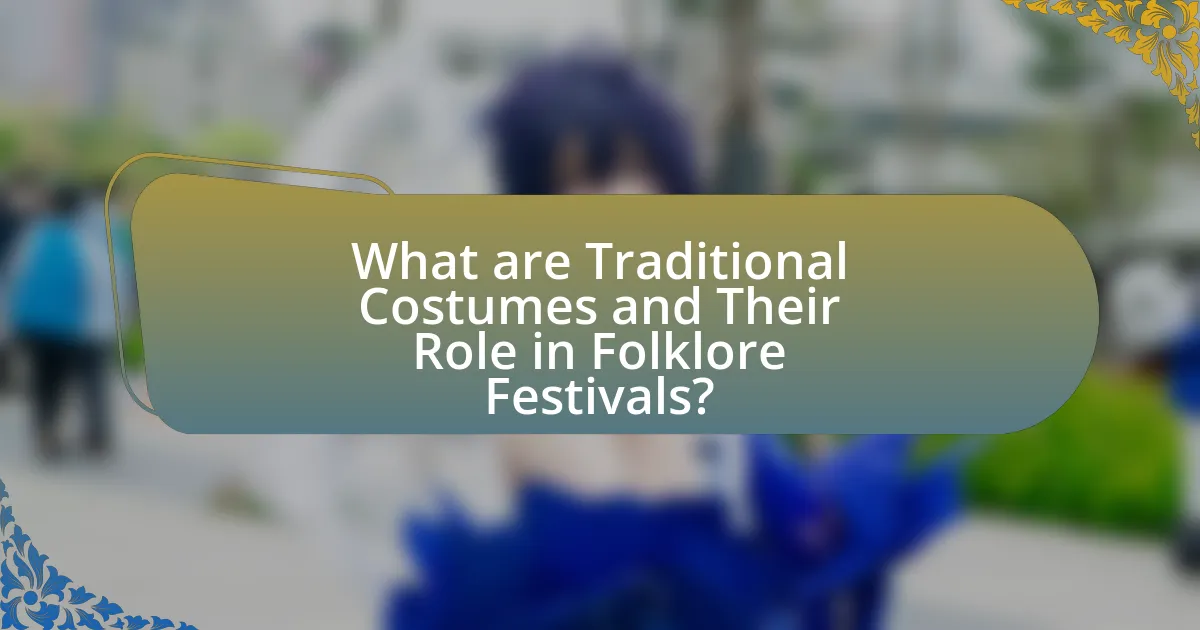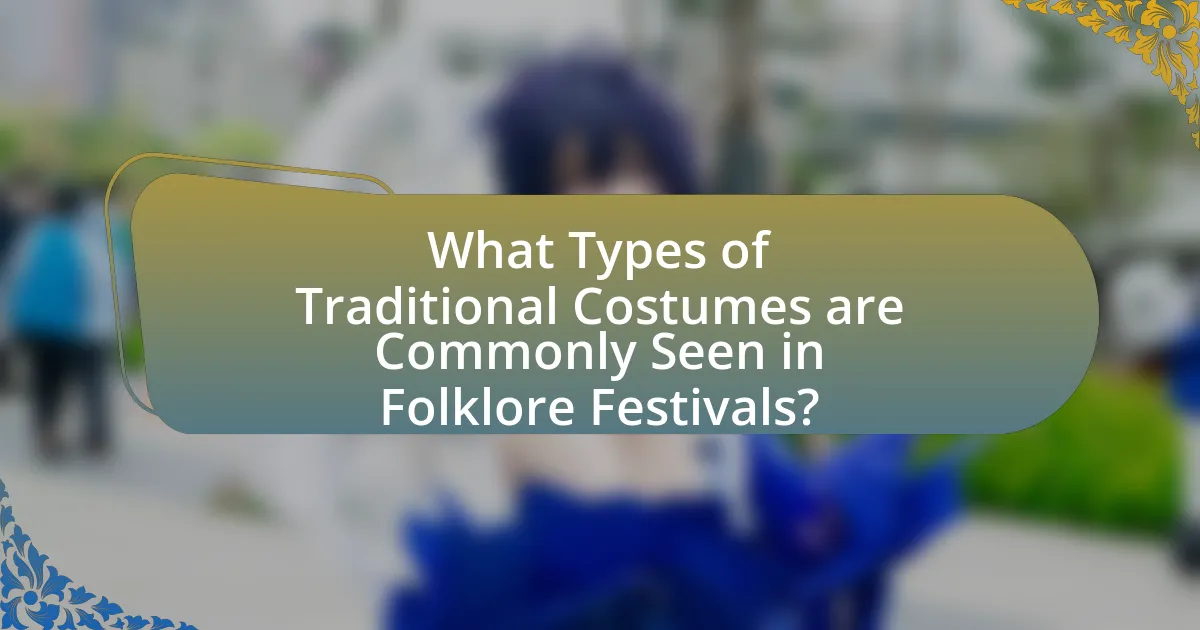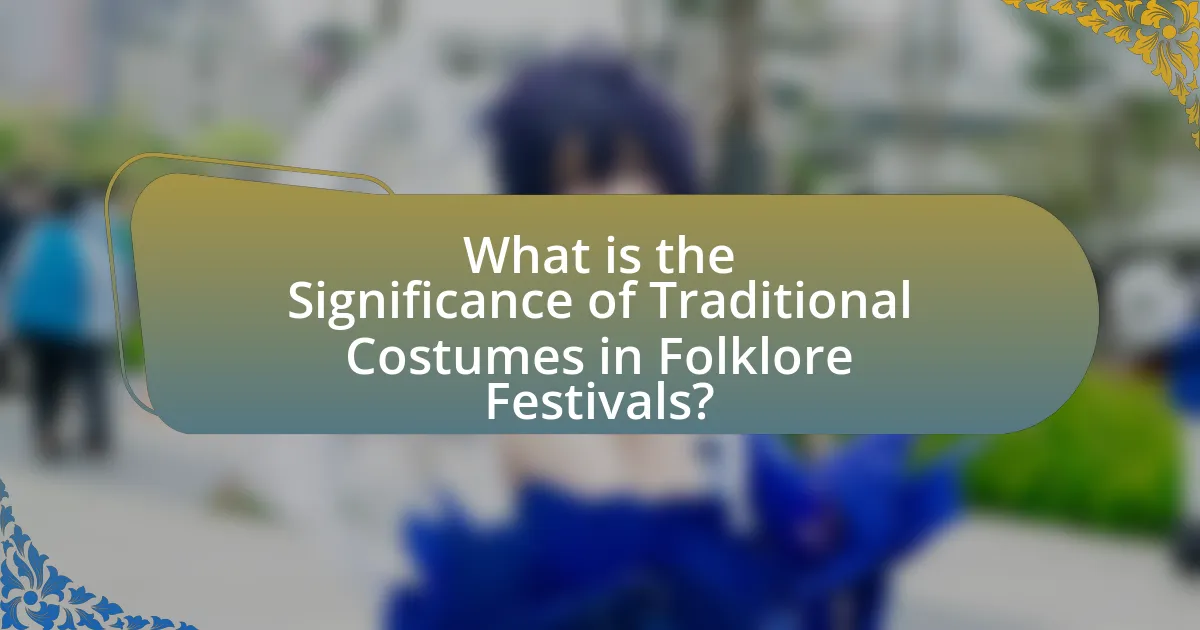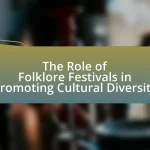Traditional costumes are garments that embody the cultural heritage and identity of communities, playing a vital role in folklore festivals. These costumes visually represent traditions, stories, and values, enhancing the festival experience through storytelling and fostering community bonds. The article explores how traditional costumes reflect cultural identity, the significance of various elements such as patterns and materials, and the challenges they face in contemporary contexts. It also discusses the evolution of these costumes, the influence of younger generations, and efforts to preserve their authenticity amidst globalization and commercialization.

What are Traditional Costumes and Their Role in Folklore Festivals?
Traditional costumes are garments that reflect the cultural heritage and identity of a community, often characterized by unique designs, colors, and materials specific to a region. In folklore festivals, these costumes play a crucial role by visually representing the traditions, stories, and values of the culture being celebrated. They serve as a medium for storytelling, allowing participants to embody historical figures or mythical characters, thereby enhancing the overall experience of the festival. Additionally, traditional costumes foster a sense of community and belonging among participants, as they often involve collective efforts in their creation and wearing. This connection to cultural roots is vital for preserving heritage and promoting cultural awareness, making traditional costumes an integral part of folklore festivals.
How do traditional costumes reflect cultural identity in folklore festivals?
Traditional costumes reflect cultural identity in folklore festivals by embodying the historical, social, and artistic expressions of a community. These garments often incorporate specific colors, patterns, and materials that are unique to a culture, showcasing its heritage and traditions. For instance, the use of traditional embroidery techniques in costumes can signify regional craftsmanship and cultural narratives, while specific attire may represent social status or historical events significant to that community. The presence of these costumes during festivals serves to reinforce group identity, foster community pride, and educate outsiders about the cultural values and history of the group.
What elements of traditional costumes signify cultural heritage?
Elements of traditional costumes that signify cultural heritage include specific patterns, colors, materials, and styles that are unique to a particular culture or community. For instance, intricate embroidery often reflects historical narratives or local flora and fauna, while specific color combinations may symbolize cultural beliefs or social status. Additionally, the use of traditional fabrics, such as silk or wool, can indicate regional craftsmanship and economic history. Historical examples include the use of tartan patterns in Scottish kilts, which denote clan identity, and the vibrant textiles of Mexican traditional dress, which represent indigenous heritage. These elements collectively serve as visual markers of cultural identity and continuity, preserving the stories and traditions of communities through generations.
How do traditional costumes vary across different regions?
Traditional costumes vary significantly across different regions due to cultural, historical, and environmental influences. For instance, in Japan, the kimono reflects the country’s aesthetic values and social status, while in Scotland, the kilt symbolizes national pride and heritage. Additionally, the vibrant colors and intricate designs of Mexican folk dresses, such as the huipil, showcase indigenous craftsmanship and regional identity. These variations are often rooted in local traditions, materials available, and historical events, illustrating how traditional costumes serve as a visual representation of cultural diversity and community values.
Why are traditional costumes important in the context of folklore festivals?
Traditional costumes are important in the context of folklore festivals because they serve as visual representations of cultural identity and heritage. These costumes embody the history, traditions, and values of a community, allowing participants to express their cultural narratives. For instance, specific patterns, colors, and styles often have historical significance, reflecting the region’s customs and social structures. Additionally, traditional costumes enhance the authenticity of folklore festivals, fostering a sense of belonging and continuity among community members while educating audiences about diverse cultural practices.
What role do traditional costumes play in storytelling during festivals?
Traditional costumes serve as vital tools for storytelling during festivals by visually representing cultural narratives and historical events. These garments often embody specific characters, myths, or traditions, allowing participants to convey stories through their attire. For instance, in many cultures, costumes are designed to reflect the roles of deities, ancestors, or folkloric figures, thus enhancing the audience’s understanding of the narrative being presented. The use of colors, patterns, and symbols in these costumes often carries significant meaning, linking the visual elements to the stories being told. This connection between costume and narrative is evident in festivals worldwide, where traditional attire not only enriches the storytelling experience but also preserves cultural heritage and fosters community identity.
How do traditional costumes enhance the overall festival experience?
Traditional costumes enhance the overall festival experience by visually representing cultural heritage and fostering a sense of community among participants. These costumes serve as a tangible connection to history, allowing individuals to express their identity and pride in their cultural background. For instance, during the Oktoberfest in Germany, traditional attire like lederhosen and dirndls not only adds to the festive atmosphere but also reinforces the celebration of Bavarian culture, attracting millions of visitors each year. This visual representation of tradition encourages engagement and participation, making the festival more immersive and memorable for attendees.

What Types of Traditional Costumes are Commonly Seen in Folklore Festivals?
Traditional costumes commonly seen in folklore festivals include regional attire such as dirndls and lederhosen in Germany, kimonos in Japan, and saris in India. These costumes often reflect the cultural heritage, history, and identity of specific communities. For instance, the dirndl and lederhosen are emblematic of Bavarian culture, showcasing traditional craftsmanship and local materials. Similarly, kimonos represent Japanese aesthetics and are often worn during seasonal festivals, symbolizing respect for tradition. Saris, worn by women in India, highlight the diversity of regional styles and fabrics, each with its own significance. These costumes not only serve as visual representations of cultural pride but also play a crucial role in preserving and promoting folklore traditions during festivals.
What are the most popular traditional costumes in various cultures?
The most popular traditional costumes in various cultures include the kimono from Japan, the sari from India, the kilt from Scotland, and the huipil from Mexico. The kimono, characterized by its intricate designs and rich fabrics, is worn during festivals and ceremonies, reflecting Japan’s cultural heritage. The sari, a long piece of cloth elegantly draped, represents India’s diverse traditions and is often worn during significant events. The kilt, a knee-length skirt-like garment made of tartan fabric, symbolizes Scottish identity and is commonly worn during Highland games and celebrations. The huipil, a traditional garment made by indigenous women in Mexico, showcases vibrant colors and intricate embroidery, representing cultural identity and heritage. Each of these costumes not only serves as attire but also embodies the history, values, and artistic expressions of their respective cultures.
How do materials and colors used in costumes differ by region?
Materials and colors used in costumes differ by region due to cultural traditions, available resources, and climatic conditions. For instance, in tropical regions, lightweight fabrics like cotton and linen are prevalent, while colder regions often utilize heavier materials such as wool and fur for warmth. Additionally, colors are influenced by local flora, fauna, and historical significance; for example, vibrant colors like red and yellow are common in African costumes, symbolizing vitality and celebration, whereas muted tones may be more typical in European traditional attire, reflecting historical austerity. This regional variation is evident in festivals, where costumes not only represent local identity but also convey specific cultural narratives and values.
What are the historical influences on specific traditional costumes?
Historical influences on specific traditional costumes stem from cultural exchanges, social status, and regional resources. For instance, the kimono in Japan reflects the influence of Chinese clothing styles, while the Scottish kilt is rooted in the clan system and local materials like wool. Additionally, colonialism has impacted traditional costumes, as seen in the fusion of indigenous and European styles in Latin American attire. These influences are evident in the patterns, colors, and materials used, which often signify historical events, social hierarchies, and geographical conditions.
How do traditional costumes evolve over time in folklore festivals?
Traditional costumes in folklore festivals evolve over time through a combination of cultural exchange, modernization, and reinterpretation of historical garments. As societies interact, elements from different cultures are integrated into traditional attire, leading to hybrid styles that reflect contemporary influences while maintaining historical roots. For instance, the incorporation of new materials and techniques can enhance the aesthetic appeal and functionality of costumes, as seen in the use of synthetic fabrics alongside traditional textiles. Additionally, festivals often adapt costumes to resonate with younger generations, ensuring that the attire remains relevant and engaging. This evolution is evidenced by the changing designs observed in annual folklore festivals, where traditional motifs may be stylized or reimagined to reflect current fashion trends while still honoring cultural heritage.
What factors contribute to the modernization of traditional costumes?
The modernization of traditional costumes is influenced by cultural exchange, technological advancements, and changing societal values. Cultural exchange occurs through globalization, where traditional garments are adapted to incorporate elements from various cultures, making them more relevant to contemporary audiences. Technological advancements, such as digital printing and online retail, enable designers to create innovative designs that blend traditional aesthetics with modern fashion trends. Additionally, changing societal values, including a focus on sustainability and inclusivity, encourage the reimagining of traditional costumes to reflect current social issues and diverse identities. These factors collectively drive the evolution of traditional costumes, ensuring their continued relevance in modern contexts.
How do younger generations influence traditional costume designs?
Younger generations influence traditional costume designs by incorporating contemporary aesthetics and personal expression into traditional garments. This shift is evident as younger designers often blend modern materials, colors, and styles with historical elements, creating a fusion that resonates with current cultural trends. For instance, the use of sustainable fabrics and innovative techniques reflects a growing awareness of environmental issues among youth, which is reshaping how traditional costumes are produced and perceived. Additionally, social media platforms allow younger individuals to showcase their reinterpretations of traditional attire, further popularizing these modern adaptations and encouraging a dialogue about cultural heritage.

What is the Significance of Traditional Costumes in Folklore Festivals?
Traditional costumes in folklore festivals are significant as they serve as a visual representation of cultural identity and heritage. These costumes embody the history, traditions, and values of a community, often reflecting regional styles, materials, and craftsmanship. For instance, in many cultures, specific colors and patterns in traditional attire symbolize various aspects of life, such as fertility, prosperity, or social status. Additionally, wearing these costumes during festivals fosters a sense of belonging and pride among participants, reinforcing communal bonds and cultural continuity. Historical evidence shows that such practices have been integral to preserving cultural narratives and practices across generations, making traditional costumes vital to the authenticity and vibrancy of folklore festivals.
How do traditional costumes contribute to community bonding during festivals?
Traditional costumes significantly enhance community bonding during festivals by fostering a shared cultural identity among participants. When individuals wear traditional attire, they visually express their heritage, which promotes a sense of belonging and unity within the community. This collective display of cultural pride encourages interactions among community members, as they engage in conversations about their traditions and shared experiences.
Research indicates that festivals featuring traditional costumes can strengthen social ties; for example, a study published in the Journal of Cultural Sociology found that participants reported increased feelings of connectedness and community spirit when engaging in cultural celebrations that included traditional dress. This evidence underscores the role of traditional costumes in reinforcing social cohesion and enhancing communal relationships during festive occasions.
What are the social implications of wearing traditional costumes at festivals?
Wearing traditional costumes at festivals fosters cultural identity and community cohesion. These costumes serve as visual representations of heritage, allowing individuals to express their cultural backgrounds and connect with their roots. For instance, studies show that participation in cultural festivals, where traditional attire is worn, enhances social bonding and reinforces group identity among participants. Additionally, traditional costumes can promote inclusivity and respect for diversity, as they invite others to appreciate and learn about different cultures. This is evidenced by events like the Carnival in Brazil, where the vibrant display of traditional costumes not only celebrates Brazilian culture but also attracts global attention, fostering intercultural dialogue and understanding.
How do traditional costumes promote cultural exchange among attendees?
Traditional costumes promote cultural exchange among attendees by serving as visual representations of diverse cultural identities and histories. When individuals wear traditional attire, they invite conversations about their cultural backgrounds, fostering curiosity and understanding among attendees from different regions. For instance, during folklore festivals, participants often engage in discussions about the origins, meanings, and craftsmanship of the costumes, which enhances mutual appreciation and respect for various cultures. This interaction is supported by studies indicating that cultural attire can significantly influence social interactions and perceptions, thereby facilitating a richer exchange of cultural knowledge and experiences among festival-goers.
What challenges do traditional costumes face in contemporary folklore festivals?
Traditional costumes face several challenges in contemporary folklore festivals, primarily including commercialization, cultural appropriation, and the loss of authenticity. Commercialization often leads to the alteration of traditional designs to appeal to broader audiences, which can dilute their cultural significance. Cultural appropriation occurs when elements of traditional costumes are adopted by individuals outside the culture without understanding or respecting their origins, leading to misrepresentation. Additionally, the pressure to modernize or simplify traditional costumes for ease of wear can result in a departure from their original craftsmanship and meaning, undermining their role in preserving cultural heritage.
How do globalization and commercialization impact traditional costumes?
Globalization and commercialization significantly alter traditional costumes by promoting homogenization and commodification. As cultures interact globally, traditional garments often lose their unique characteristics, becoming standardized to appeal to broader markets. For instance, the rise of fast fashion has led to the mass production of clothing that mimics traditional designs, diluting their cultural significance. A study by the University of California found that over 70% of traditional attire in various cultures is now produced for commercial purposes, often prioritizing profit over authenticity. This shift not only affects the craftsmanship and meaning behind these costumes but also risks the erosion of cultural heritage associated with them.
What efforts are being made to preserve traditional costumes in festivals?
Efforts to preserve traditional costumes in festivals include documentation, community workshops, and educational programs. Organizations and cultural institutions are actively documenting traditional costumes through photography and written records to ensure their historical significance is maintained. Community workshops engage local artisans and youth in the crafting and wearing of traditional attire, fostering skills transfer and cultural pride. Educational programs in schools and cultural centers teach the history and importance of these costumes, promoting awareness and appreciation among younger generations. These initiatives collectively contribute to the safeguarding of cultural heritage associated with traditional costumes in festivals.
What are some best practices for participating in folklore festivals with traditional costumes?
To effectively participate in folklore festivals with traditional costumes, individuals should prioritize authenticity, cultural respect, and proper presentation. Authenticity involves researching the specific cultural background of the costume to ensure accurate representation, as many traditional costumes carry historical significance and symbolism. Cultural respect is crucial; participants should understand the customs and traditions associated with the attire to avoid cultural appropriation. Proper presentation includes wearing the costume correctly, maintaining its condition, and adhering to any guidelines set by festival organizers. These practices enhance the overall experience and contribute to the preservation of cultural heritage.















